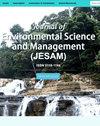Determination of Perfluorooctanoic Acid and Perfluorooctane Sulfonate Water Quality Criteria for Ecosystem Protection of Laguna Lake, Philippines
IF 0.3
4区 环境科学与生态学
Q4 ENVIRONMENTAL SCIENCES
引用次数: 0
Abstract
Perfluorooctanoic acid (PFOA) and perfluorooctane sulfonate (PFOS) are organic chemicals which pose concerns in the environment due to their persistence and bioaccumulative properties. This study used Assessment Factors and Species Sensitivities Distributions to derive specific thresholds to protect the ecosystem in the Laguna Lake, Philippines from risks posed by the toxicity of PFOS and PFOA using available ecotoxicity data for local species. For Assessment Factor method, the U.S. Environmental Protection Agency guideline for the narrative Tier II criteria was suitable based on the available toxicity data with calculated maximum concentration threshold for PFOS and PFOA of 0.51 and 0.75 mg L-1, respectively, and continuous maximum concentration values of 0.06 and 0.08 mg L-1, respectively. For the methods using Species Sensitivity Distribution (SSD), PFOS and PFOA thresholds extrapolated using factors for small datasets were 0.046 and 0.088 mg L-1, respectively. Lastly, PFOS and PFOA Hazardous Concentration (HC5) extrapolated from the weighted average SSD model estimates were 0.061 and 0.078 mg L-1, respectively. The results can serve as the first regulatory and risk assessment basis for aquatic ecosystem protection against risks posed by emerging contaminants in the lake.菲律宾拉古纳湖生态系统保护用全氟辛酸和全氟辛烷磺酸水质标准的测定
全氟辛酸(PFOA)和全氟辛烷磺酸(PFOS)是有机化学品,由于其持久性和生物蓄积性,在环境中引起关注。本研究利用评估因子和物种敏感性分布,利用现有的当地物种生态毒性数据,得出保护菲律宾拉古纳湖生态系统免受全氟辛烷磺酸和全氟辛酸毒性风险的特定阈值。对于评估因子法,基于现有毒性数据,美国环境保护署(epa)的二级叙事标准指南适用于全氟辛烷磺酸(PFOS)和全氟辛烷磺酸(PFOA)的最大浓度阈值分别为0.51和0.75 mg L-1,连续最大浓度分别为0.06和0.08 mg L-1。采用物种敏感性分布(SSD)的方法,小数据集的因子外推的PFOS和PFOA阈值分别为0.046和0.088 mg L-1。最后,根据SSD模型的加权平均值推断,PFOS和PFOA有害浓度(HC5)分别为0.061和0.078 mg L-1。研究结果可作为湖泊新出现污染物对水生生态系统风险保护的第一个监管和风险评估依据。
本文章由计算机程序翻译,如有差异,请以英文原文为准。
求助全文
约1分钟内获得全文
求助全文
来源期刊

Journal of Environmental Science and Management
ENVIRONMENTAL SCIENCES-
CiteScore
0.90
自引率
0.00%
发文量
10
审稿时长
2 months
期刊介绍:
The Journal of Environmental Science and Management (JESAM) is an international scientific journal produced semi-annually by the University of the Philippines Los Baños (UPLB).
JESAM gives particular premium to manuscript submissions that employ integrated methods resulting to analyses that provide new insights in environmental science, particularly in the areas of:
environmental planning and management;
protected areas development, planning, and management;
community-based resources management;
environmental chemistry and toxicology;
environmental restoration;
social theory and environment; and
environmental security and management.
 求助内容:
求助内容: 应助结果提醒方式:
应助结果提醒方式:


